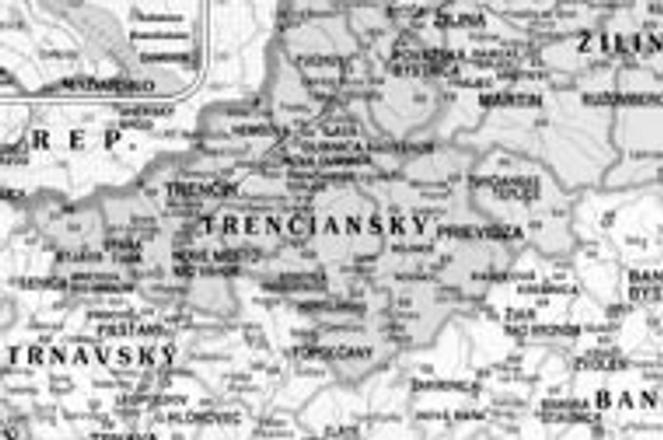The Trenčin region is one of the smaller regions in Slovakia. It has a long northwest border with the Czech Republic. The dominant town is Trenčín, but also other towns such as Prievidza and Považská Bystrica are not any less in stature. History runs as long as the Vah river that cuts through the hills. The Romans extended their northern border of their empire in Trenčin and the region gave birth to three great Slovak personslities in history: Ludovit Štur, Milan-Rastislav Štefanik and Alexander Dubček.
Though the path is steep, anyone journeying up the Trenčín castle hill surely won't regret the effort. The bird's eye view from the top shows the old town surrounded by sturdy, ancient walls, old houses clinging to one another behind fancy modern buildings, and a stream of cars heading toward the center. The glistening blue of the Vah river separates the old town from its dreary industrial districts.
It is not difficult to imagine ancient peoples like the Celts, Germans and Slavs surveying the landscape from the very same hill. The renowned Greek historian and astronomer Ptholemaios, in the 2nd century AD drew a map of the then-known world which depicted a settlement named Leukaristos (Greek for the Latin name Laugaritio) where Trenč'n lies today.
Laugaritio was founded after the Romans seized Podunajsko (a region along the Danube river) and established a province known as Panony. The Romans built many fortified military settlements to guard the northern border of their empire. In campaigns against barbarian tribes, the Romans moved ever further north until they finally established the military camp of Laugaritio.
Unequivocal evidence proves that the Romans came, saw, and conquered the Laugaritio environs. An inscription commemorating a victory by Roman troops over the so-called Markomans is chiselled into a cliff rock, and was written by Marcus Valerius Maximianus in the year 179 A.D. The inscription states:"To the victory of the emperor and his army of 855 soldiers, residing at Laugaricio. Inscribed by the order of Maximianus, legate of the llth auxiliary legion." The inscription can be seen through a glass wall inside the hotel Tatra next to the castle hill.
In the centuries that followed, Trenčín's history has been linked inseparably with the fortunes of the castle. The castle is first mentioned in the year 1067 as a royal guard castle for the Hungarians. After the year 1302, the fortress was owned by Matuš Čak, "the mighty lord of the Vah and the Tatras" as he liked to be known. Under his governance the castle became the most powerful in all Povazie, a northern province in the Hungarian empire. Between 1430 and 1527, under the new ownership of the Luxemburg and Zapolsky families, the castle was expanded with new buildings being constructed and the whole complex fortified.
A jewel among medieval fortresses. Take a trip back in time with each step up Trenčín castle hill.Lubica Sokolíková
The important medieval town of Trencin developed from a market settlement around the castle. On February 19, 1412, (this year is the 585 th anniversary) the ruler Sigismond of Luxemburg raised the status of the town of TrencŞn to that of a free royal town with special privileges - the right to vote for a village J.P. and administer oaths - the right to create independent legislation - the right of the sword - the right to storage - the right to be fortified with city walls - the power of patronage of a town church. The town henceforth held two weekly markets and eight yearly markets. Slovak merchants from towns both near and far, and merchants from Moravia and Bohemia took part in these markets, which provided vital business contacts with Austria, North Hungary and Poland.
The plaque column in the middle of the square was raised in 1713 by Miklos Illeshazy in commemoration of the end of great plague. Visitors can pass behind the town walls through the Lower Gate, also known as the "Turkish gate", which features a clock tower from the 15 century. The large synagogue building is at present used for various art exhibitions. Coming out of the old centre, on Vajanskeho street the architecture suddenly changes into an ugly functionalist style, with the Prior department store and Hotel Laugaritio offering typical examples of socialist buildings. Laugaritio was once the best hotel in town, especially in the 70ties. Now it is run-down and boarded up. The eyes of passers by are grateful for the distraction of the ultra modern, glass and marble building of the Czechoslovak Commercial Bank on the opposite side.


